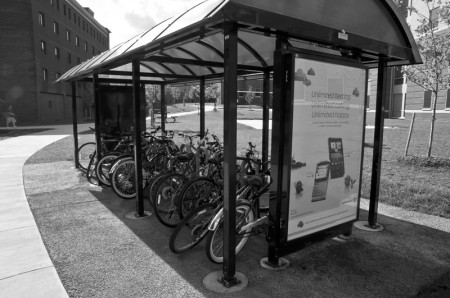
One of the new bike shelters built in Spring 2011 in response to the growing number of bikes on campus. Photo by Stephen Kline
As the gas prices rise and awareness increases for environmentally friendly transportation, George Mason University is making an effort to become more bike friendly.
“I’ve definitely noticed the number of bike racks around campus,” freshmen marketing major Brent Seth said. “It was one of the first things I noticed when I first got here.”
This is not a surprise, as Mason has boosted the number of bike racks outside facilities and school buildings to keep up with the growing bike-riding population. According to the Mason Transportation Department’s webpage, one of the main selling points for a student to start biking to and around campus is the relative cost-effectiveness. They stated that while the initial costs of the bike itself and the safety equipment exist, they are merely a fraction of the cost involved in maintaining a car, a required parking pass,
insurance and ever-rising gas prices.
“I can definitely see the allure behind riding a bike [as opposed to driving a car],” sophomore government and international politics major Rita Halabi said. “Mason has really made an effort to get students biking to and from school.”
The Mason Transportation Department’s webpage also claims that biking to and from school can be a great workout, stating that a 20-minute morning and afternoon aerobic workout is greatly beneficial to an individual’s overall fitness.
They also state that here, in temperate northern Virginia, a student could potentially ride year round.
“I could see riding a bike here for the sole purpose of an excuse to get a workout,” said Robin Brooks, an undeclared freshman. “It’s like killing two birds with one stone, really, because you have to go to class — might as well make the trip into a nice little workout.”
Mason has even gone so far as to include a webpage assisting the potential biker with the specifications for the bike he or she should choose.
The page lists various types of bicycles available from touring, to road, mountain and hybrid, along with the positives and negatives of each.
“I think the best type of bike to have on campus would be a nice cruiser, although you would need gears on it because of all the hills up here,” said Halabi.
The last, and possibly most practical, reason that Mason is adopting a bike-friendly attitude is the sheer accessibility.
It is relatively easy to add new bike racks all over campus as the biking community increases, but it is far more difficult to add parking lots.
“I live on campus, but I could definitely see why people would rather bike to campus,” Seth said, “if only for the reason that they would get to park 20 feet from their classroom instead of a half-mile away.”






Comments